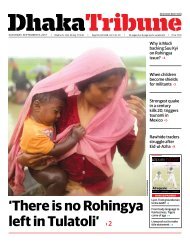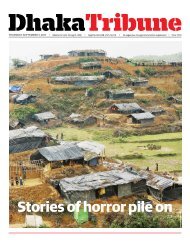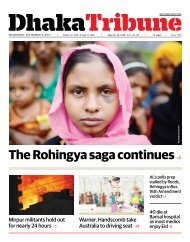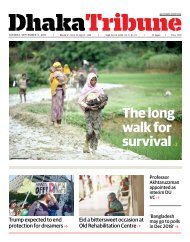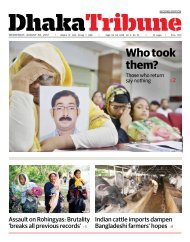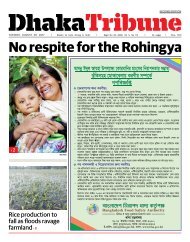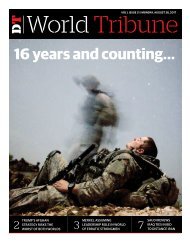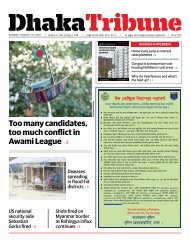DT e-Paper, Saturday, October 15, 2016
Create successful ePaper yourself
Turn your PDF publications into a flip-book with our unique Google optimized e-Paper software.
14<br />
SATURDAY, OCTOBER <strong>15</strong>, <strong>2016</strong><br />
<strong>DT</strong><br />
Climate Change<br />
The river that eats up land and homes<br />
• Rafiqul Islam<br />
Piyara Begum once had a<br />
happy life in Garuhara<br />
village by the Brahmaputra<br />
River in northern<br />
Bangladesh, but worsening erosion<br />
of the river banks has displaced<br />
her family seven times.<br />
Now Piyara, 30, has taken<br />
shelter in Panchgachi village, 8<br />
kilometres away in the same subdistrict<br />
of Kurigram Sadar.<br />
“I am always concerned about<br />
where Piyara and her three<br />
children are living, and how she<br />
manages her family expenses,<br />
as she has lost everything due to<br />
erosion,” said her uncle, Abdul<br />
Majid, who still lives in Garuhara<br />
village.<br />
The loss of Piyara’s home is<br />
taking a toll on her mental and<br />
physical health, he added.<br />
Riverbank erosion is a common<br />
problem along the mighty<br />
Brahmaputra during the monsoon,<br />
but scientists say climate change<br />
is making the phenomenon worse<br />
by contributing to higher levels of<br />
flooding and siltation.<br />
According to villagers in<br />
Garuhara, about 200 families have<br />
been displaced by erosion there in<br />
the last two years.<br />
Majid fears that if the trend<br />
continues, the whole of the village<br />
will go underwater, rendering<br />
about 1,000 families homeless.<br />
But some of those who want<br />
to escape that prospect cannot -<br />
because they are unable to turn<br />
their assets into the cash they<br />
need to pay for their move.<br />
Abdul Malek, 45, a farmer<br />
in Garuhara, had 0.4 acres of<br />
agricultural land on the bank of<br />
the Brahmaputra, but the river<br />
washed away half his plot during<br />
the monsoon last year.<br />
“My family had no problem in<br />
the past as we cultivated crops on<br />
the land to meet our food demand.<br />
But now we are facing trouble,”<br />
he said.<br />
Malek and his family are<br />
planning to migrate to another<br />
part of the country after selling<br />
their homestead, but they cannot<br />
find a buyer because the property<br />
is at high risk of erosion.<br />
Other families in Garuhara<br />
village who also want to sell up<br />
and leave are trapped there for the<br />
same reason.<br />
Erosion rates rising<br />
The Brahmaputra is a<br />
transboundary river, originating<br />
in southwestern Tibet, flowing<br />
through the Himalayas, India’s<br />
Assam State and Bangladesh, and<br />
out into the Bay of Bengal.<br />
Climate change has contributed<br />
to rapid siltation of the river in<br />
recent years, which is intensifying<br />
bank erosion during the monsoon,<br />
Locals look at the erosion left by the river Jamuna, in Sariakandi, near Bogra town, 250km northwest of the capital<br />
Riverbank erosion works like a silent cancer and can be more<br />
devastating than storms or floods because it takes everything<br />
people own, including their land<br />
Bangladesh Water Resources<br />
Minister Anisul Islam Mahmud<br />
told the Thomson Reuters<br />
Foundation.<br />
A 2014 study from the<br />
International Union for<br />
Conservation of Nature showed<br />
that the flow of the Brahmaputra<br />
is influenced strongly by the<br />
melting of snow and ice upstream,<br />
mainly in the eastern Himalaya<br />
mountains.<br />
This century, as temperatures<br />
rise, the river is likely to see<br />
an overall increase in flows<br />
throughout the year, driven by<br />
more rainfall, higher snow melt<br />
rates, and expanded run-off areas,<br />
the study said.<br />
Every year, the river carries silt<br />
from the Himalayas and deposits<br />
it downstream in Bangladesh,<br />
creating myriad islands known as<br />
chars.<br />
When floods occur upstream<br />
on the Brahmaputra, amid more<br />
intense bursts of heavy rainfall<br />
linked to climate change, the<br />
silted-up river has less capacity to<br />
carry the huge volume of water,<br />
accelerating bank erosion.<br />
Maminul Haque Sarker of the<br />
Center for Environmental and<br />
Geographic Information Services<br />
(CEGIS), a Dhaka-based think tank,<br />
said the erosion rate has increased<br />
at some points of the river in<br />
Kurigram, Gaibandha, Jamalpur,<br />
and Sirajganj districts.<br />
A 20<strong>15</strong> CEGIS study put the<br />
annual rate of erosion along the<br />
Brahmaputra at around 2,000<br />
hectares (4,942 acres) in recent<br />
years.<br />
Bangladesh’s major rivers<br />
combined consume several<br />
thousand hectares of floodplain<br />
annually, destroying homes and<br />
infrastructure and leaving people<br />
landless and homeless.<br />
Silent cancer<br />
A 2013 study by the Refugee and<br />
Migratory Movements Research<br />
Unit at the University of Dhaka and<br />
the UK-based Sussex Centre for<br />
Migration Research estimated that<br />
riverbank erosion displaces 50,000<br />
to 200,000 people in Bangladesh<br />
every year.<br />
Those displaced by erosion<br />
become isolated from their<br />
families and wider social<br />
networks, and most have no scope<br />
to return to their roots.<br />
Majid from Garuhara village<br />
said many of his neighbours and<br />
relatives have already left for other<br />
parts of the country and do not see<br />
each other even once a year.<br />
Minister Mahmud said<br />
riverbank erosion works like a<br />
silent cancer and can be more<br />
devastating than storms or floods<br />
because it takes everything people<br />
own, including their land.<br />
“People have the chance to<br />
return to a normal life if they are<br />
hit by a cyclone or flood,” he told<br />
the Thomson Reuters Foundation.<br />
“If people once become displaced<br />
due to bank erosion, it is quite<br />
impossible to return to normal<br />
life.”<br />
CEGIS deputy executive<br />
director Fida A Khan said people<br />
often have family cemeteries or<br />
other religious monuments on<br />
the riverbanks that are claimed by<br />
erosion. Those structures may not<br />
be worth much economically, but<br />
have high social value, he added.<br />
Jahera Begum, 45, another<br />
REUTERS<br />
victim of riverbank erosion, had<br />
a homestead in Balchipara village<br />
in Kurigram Sadar sub-district,<br />
but the river washed away all<br />
the village land during last year’s<br />
monsoon, uprooting about 100<br />
families.<br />
“My husband has already gone<br />
to Feni district seeking work. I am<br />
temporarily taking shelter in my<br />
relatives’ house at Garuhara,” said<br />
Jahera, who is planning to head to<br />
Feni or even Dhaka soon.<br />
Bank erosion has not<br />
only claimed all her family’s<br />
belongings, but has left them<br />
facing an uncertain future, she<br />
said grimly. •<br />
Rafiqul Islam is a freelance contributor<br />
to the Thomson Reuters Foundation,<br />
writing on climate change issues<br />
from Dhaka, contributing stories on<br />
climate change issues. This piece was<br />
originally published by Thomas Reuters<br />
Foundation, the charitable arm of<br />
Thomson Reuters, which can be found<br />
here: http://news.trust.org/climate.<br />
This page has been developed in<br />
collaboration with the International<br />
Centre for Climate Change and Development<br />
(ICCCAD) at Independent<br />
University, Bangladesh (IUB) and<br />
its partners, Bangladesh Centre for<br />
Advanced Studies (BCAS) and International<br />
Institute for Environment<br />
and Development (IIED). This page<br />
represents the views and experiences<br />
of the authors and does not necessarily<br />
reflect the views of Dhaka Tribune<br />
or ICCCAD or its partners.




